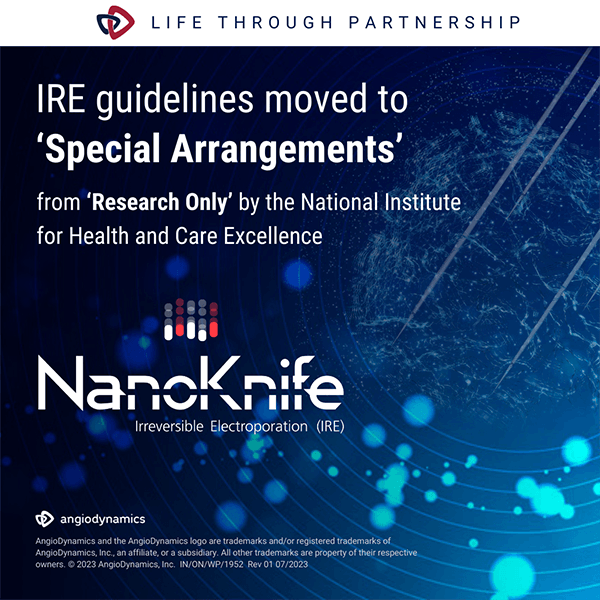NICE Irreversible Electroporation for Treating Prostate Cancer Announcement
 Around half of all men say lack of sexual function is a significant problem to them after prostate cancer intervention, highlighted in an international survey from 32 countries and over 5000 men by the Europa-Uomo group1. Real world evidence is important to understand what is happening to patients in healthcare2, so AngioDynamics welcomed the news last week that the UK’s National Institute for Health and Care Excellence (NICE) Interventional Procedures Advisory Committee (IPAC) upgraded the guidance for Irreversible Electroporation for Prostate Cancer from “Research Only” to “Special Arrangements” using clinical evidence solely created using the NanoKnife System (https://www.nice.org.uk/guidance/ipg768). Safety is an important metric for any medical technology, and NICE declared “no major safety concerns in the short- and medium term.” Now hospitals can use the technology while we learn more about the long term (>10 years) outcomes of using the NanoKnife System for prostate cancer as they collect their audit data.
Around half of all men say lack of sexual function is a significant problem to them after prostate cancer intervention, highlighted in an international survey from 32 countries and over 5000 men by the Europa-Uomo group1. Real world evidence is important to understand what is happening to patients in healthcare2, so AngioDynamics welcomed the news last week that the UK’s National Institute for Health and Care Excellence (NICE) Interventional Procedures Advisory Committee (IPAC) upgraded the guidance for Irreversible Electroporation for Prostate Cancer from “Research Only” to “Special Arrangements” using clinical evidence solely created using the NanoKnife System (https://www.nice.org.uk/guidance/ipg768). Safety is an important metric for any medical technology, and NICE declared “no major safety concerns in the short- and medium term.” Now hospitals can use the technology while we learn more about the long term (>10 years) outcomes of using the NanoKnife System for prostate cancer as they collect their audit data.
When men are diagnosed with prostate cancer it is graded as Low, Intermediate or High risk. As documented in the NICE guidance, Low risk should generally be placed on Active Surveillance where men are followed up to ensure the cancer is not growing or in need of an intervention. Intermediate and High risk are offered radical treatment in the form of Surgery or Radiotherapy that treats the whole prostate3. The potential side effects of these treatments are mostly around quality of life (erectile function, urinary incontinence, bowel discomfort). Focal treatment is where doctors target only the cancer that requires intervention and can be the bridge between active surveillance and radical treatment. This is like other cancers such as kidney and breast cancer, where treating the cancer while preserving the healthy tissue is the first consideration for treatment rather than full nephrectomy or mastectomy. Men with localized intermediate risk prostate cancer, meaning cancer has not spread from the prostate, would benefit most from focal treatment4. Specifically, successful focal treatment minimises the side effects of radical treatment while destroying the significant cancer or delaying or preventing a further intervention (known as failure free survival). Clinical evidence suggests that any section of the prostate can be treated with the NanoKnife System’s irreversible electroporation technology5, whereas many other focal treatments are usually confined to one section due to the mechanism of action6.
The IPAC undertook more than a year of data analysis, reviewing historical and contemporary data for the treatment of prostate cancer using irreversible electroporation7. The findings concluded that serious adverse events were extremely rare, below 1%. Even with varying techniques across many single centres, 1-3 year failure free survival was between 83-90%, erectile function if potent before intervention remained between 85-95%, and urinary incontinence practically non-existent (<5%). In particular, the CROES RCT showed it is safe even if more of the prostate is treated and the quality of life is statistically similar, although more targeted focal is trending to be better8. With 5 year median follow up data now published in Australia9, plus salvage evidence that patients can go onto radical treatment if ever needed10.
Professor Emberton OBE – Dean of the Faculty of Medical Sciences at University College London said:
“The recent NICE advice on irreversible electroporation is most timely as it will accelerate the diffusion of the technology and make it available to patients who do not live in London. We look forward to helping colleagues get their programmes up and running so that their patients can benefit, receiving a safe treatment that gives a better chance at maintaining crucial quality of life during key moments of their lives and relationships.”
While the news does mean access to the NanoKnife System’s irreversible electroporation technology will increase in the UK, we are committed to supporting further evidence both in randomized controlled trials, with two up and running and one starting soon11-13, and in longer term multi-centre registries. If you are a doctor, or patient that wants to find out more please reach out to our team.
Risk Info: https://www.angiodynamics.com/about-us/risk-information/
Citations:
1. https://www.europa-uomo.org/who-we-are/quality-of-life-2/the-euproms-study/
2. https://www.nice.org.uk/corporate/ecd9/chapter/overview
3. https://www.nice.org.uk/guidance/ng131/chapter/Recommendations#localised-and-locally-advanced-prostate-cancer – sections 1.3.8 to 1.3.12
4. https://pubmed.ncbi.nlm.nih.gov/28349978/
5. https://pubmed.ncbi.nlm.nih.gov/30211680/
6. https://pubmed.ncbi.nlm.nih.gov/29743538/
7. www.nice.org.uk/guidance/ipg768/evidence/overview-final-pdf-13121581357
8. https://pubmed.ncbi.nlm.nih.gov/36441776/
9. https://pubmed.ncbi.nlm.nih.gov/36495481/
10. https://pubmed.ncbi.nlm.nih.gov/35474600/
11. https://part.octru.ox.ac.uk/
12. https://www.sciencedirect.com/science/article/pii/S2666168323001283
13. https://www.zorginstituutnederland.nl/werkagenda/kanker/veelbelovende-zorg—focale-therapie-bestaande-uit-hifu-tulsa-en-ire-bij-mannen-van-40-jaar-en-ouder-met-een-nieuw-gediagnosticeerd-intermediair-risico-dominant-prostaatkanker-en-een-levensverwachting-van-minstens-10-jaar
